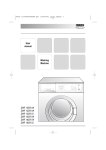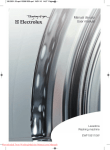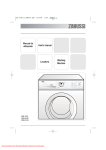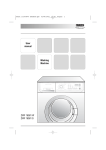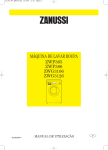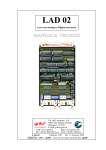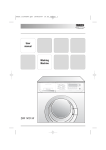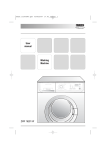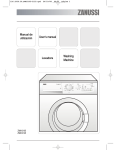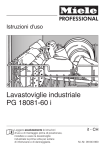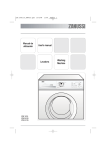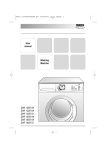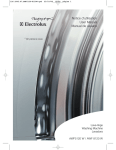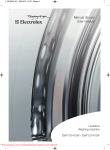Download Zanussi ZWF 6115 User`s manual
Transcript
126.2936.30…ZWF365.qxd Libretto Istruzioni 6/6/08 11:06 Página 1 User's Manual Lavabiancheria ZWF 365 Washing machine 126.2936.30…ZWF365.qxd 6/6/08 11:06 Página 2 Grazie per aver scelto il nostro prodotto Le auguriamo che la sua nuova apparecchiatura soddisfi pienamente le sue attese e auspichiamo che scelga ancora la nostra marca quando acquisterà elettrodomestici per la sua casa. La preghiamo di leggere attentamente il libretto istruzioni e di conservarlo come documentazione di riferimento. Raccomandiamo inoltre di consegnare il libretto istruzioni all'eventuale futuro possessore dell'apparecchio. In questo manuale per l’uso sono utilizzati i seguenti simboli: Informazioni importanti relative alla sicurezza e alla prevenzione di danni all’apparecchio Informazioni generali Informazioni ambientali Indice Avvertenze.....................................................3 Manutenzione e pulizia................................15 Descrizione dell’apparecchio .........................5 Anomalie di funzionamento .........................17 Cassetto detersivo .........................................5 Caratteristiche tecniche ...............................20 Pannello comandi ..........................................6 Dati di consumo...........................................21 Tabella dei programmi ...................................7 Installazione.................................................22 Guida al lavaggio...........................................9 Ambiente......................................................24 Primo utilizzo................................................11 Garanzia/Servizio clienti ..............................25 Sequenza delle operazioni ..........................12 Garanzia Europea........................................25 2 126.2936.30…ZWF365.qxd 6/6/08 11:06 Página 3 Avvertenze Queste avvertenze sono state preparate per la vostra sicurezza e quella degli altri. Si prega di leggerle attentamente prima di installare e utilizzare l'apparecchio. Vi ringraziamo per l'attenzione. Conservare questo manuale di istruzioni. In caso di rivendita o cessione ad un'altra persona, il manuale per l'uso deve accompagnare l'apparecchio. Il nuovo utente potrà conoscere il funzionamento della lavabiancheria ed essere a conoscenza degli avvertimenti relativi. ● Avvertenze generali ● ● ● ● ● ● ● ● Non modificare o cercare di modificare le caratteristiche di questo apparecchio. Questo comportamento potrebbe provocare un pericolo per l'utilizzatore. Togliere dalle tasche degli indumenti prima del lavaggio tutti gli oggetti come monete, spille di sicurezza, spille, viti, che potrebbero causare danni. Utilizzare la quantità di detersivo indicata nel paragrafo «Dosaggio dei detersivi». Raggruppare i piccoli indumenti come calzini, cinture ecc. in un sacchetto di tela o in una retina. Staccare la presa di corrente e il rubinetto dell'acqua dopo l'uso dell'apparecchio. Staccare la lavabiancheria dalla cor-rente prima di procedere alla pulizia o alla manutenzione. Non lavare a macchina articoli di biancheria con ferretti, tessuti senza orlo o strappati. ● ● ● ● ● ● ● L’apparecchio deve essere disimballato completamente prima del collegamento o dell'utilizzo. L’eliminazione incompleta dei dispositivi di protezione per il trasporto potrebbe causare danni all'apparec-chio o ai mobili vicini. Eventuali interventi idraulici richiesti devono essere eseguiti solo da un idraulico qualificato. Se l'impianto elettrico dell'abitazione richiede una modifica per il collegamento dell'apparecchio, affidare il lavoro ad un elettricista qualificato. Dopo aver installato l'apparecchio assicurarsi che non posi sul cavo di alimentazione. Se la lavabiancheria è installata su un pavimento con moquette, assicurarsi che le aperture previste per la ventilazione, poste nella parte bassa della macchina non siano ostruite. Prima di procedere al collegamento dell'apparecchio, leggere attentamente le istruzioni riportate nel capitolo «Collegamento elettrico». L'apparecchio deve essere collegato ad una presa elettrica dotata di messa a terra conforme. La sostituzione del cavo di alimentazione deve essere eseguita soltanto dal personale del Servizio di Assistenza Tecnica. La responsabilità del produttore non potrà essere richiesta per qualsiasi danno derivante da una installazione non conforme. Installazione ● Al ricevimento dell'apparecchio, disimballare immediatamente l'apparecchio. Verificare l'aspetto generale. Riportare le eventuali riserve sulla bolletta di spedizione di cui si conserverà una copia. 3 126.2936.30…ZWF365.qxd 6/6/08 11:06 Página 4 Utilizzo ● ● ● ● ● ● 4 L'apparecchio è destinato ad un normale uso domestico. Non utilizzarlo a fini commerciali o industriali o a scopi diversi da quelli per cui è stato progettato: lavaggio, risciacquo e centrifuga. Non lavare a macchina articoli che potrebbero non sopportare tale trattamento. Seguire le indicazioni riportate nelle etichette dei capi. Non mettere nella lavabiancheria capi smacchiati con benzina, alcool, tricloretilene, ecc. Se si utilizzano questi prodotti, attendere che il prodotto sia evaporato prima di porre gli articoli nel cestello. Si consiglia di non staccare mai la spina dalla presa tirando il cavo di alimentazione; disinserire la spina stessa. Non utilizzare mai la lavabiancheria se il cavo di alimentazione, il cruscotto, oppure il top sono danneggiati in modo tale da poter accedere all’interno della macchina stessa. Si consiglia di utilizzare la lavabiancheria in ambienti la cui temperatura non sia inferiore a 0°C. In caso contrario consultare il capitolo «Manutenzione e Pulizia». Sicurezza bambini ● ● ● L'apparecchio è stato progettato per essere usato da adulti. Assicuratevi che i bambini non lo tocchino e non lo utilizzino come un gioco. I componenti dell’imballo (ad esempio sacchetti di nylon, polistirolo etc.) possono diventare estremamente pericolosi per rischio di soffocamento. Teneteli lontano dalla loro portata. Conservare tutti i detersivi in un luogo sicuro lontano dalla portata dei bambini. 126.2936.30…ZWF365.qxd 6/6/08 11:06 Página 5 Descrizione dell’apparecchio 1 Cassetto detersivo 2 Pannello dei comandi 3 Maniglia oblò 4 Pompa scarico 5 Piedini regolabili Cassetto detesivo Prelavaggio Lavaggio Ammorbidente 5 126.2936.30…ZWF365.qxd 6/6/08 11:06 Página 6 Pannello comandi 1 ● Il selettore programmi permette la scelta del programma desiderato. Puo’ essere ruotato sia in senso orario che antiorario. Dopo aver selezionato il programma la spia del tasto Avvio/Pausa inizia a lampeggiare in verde. ● Questo selettore permette la scelta della temperatura desiderata. Puo’ essere ruotato solo in senso orario. 90°C temperatura massima (freddo) lavaggio a freddo. ● Premere questo tasto ripetutamente per cambiare la velocita’ di centrifuga finale se desideri che la tua biancheria venga centrifugata ad una velocita’ diversa da quella proposta dalla lavatrice oppure per selezionare l’opzione Antipiega ● Premendo questo tasto è possibile selezionare una sola delle seguenti opzioni (la spia corrispondente si accende): EASY IRON oppure SUPER QUICK. ● Premendo questo tasto la lavatrice aggiunge uno o piu risciacqui durante il ciclo di lavaggio. ● Premere «Avvio/Pausa» per avviare il programma selezionato. La spia verde integrata nel tasto smette di lampeggiare. Per interrompere un programma in corso, premere nuovamente «Avvio/Pausa»: la spia verde integrata nel tasto inizia lampeggiare. Selettore programmi Selettore per la regolazione della 2 temperatura Tasto per la regolazione della 3 centrifuga 4 Tasto Opzioni 5 Tasto Super Risciacquo 6 Tasto Avvio/Pausa 7 Luci 6 ● ● Une delle spie presenti si accende per indicare la fase di lavaggio attualmente in corso. 126.2936.30…ZWF365.qxd 6/6/08 11:06 Página 7 Tabella dei programmi Programma Cotone - Lino Cotone + Prelavaggio Cotone Eco Eco + Prelavaggio Sintetici Sintetici + Prelavaggio Tipo di tessuto Temperatura Cotoni Bianchi e Colorati resistenti ad es. biancheria da letto e da tavola, biacheria spugna. Lavaggio da 90ºC a Freddo Cotoni Bianchi, ad es. biancheria da letto e da tavola, biancheria di spugna. Lavaggio da 90ºC a Freddo Cotoni Bianchi e colorati lavato in modo eco. Lavaggio da 60ºC a Freddo Cotoni Bianchi lavato in modo eco con prelavaggio Lavaggio da 60ºC o 40º Sintetici e tessuti misti ad es. camicie, camicette, biancheria intima Lavaggio da 60ºC a Freddo Sintetici con prelavaggio. Lavaggio da 40º a Freddo Super Risciacquo Lavaggio da 40ºC a Freddo Lana lavabile in lavatrice, con la dicitura "pura lana vergine, lavabile in lavatrice, irrestringibile". Lavaggio da 40ºC a Freddo Ciclo specifico per tessuti delicati, con la dicitura "lavabile a mano per Lavaggio a mano programma di machina". Lavaggio da 40ºC a Freddo Lana No stiro, Super Risciacquo, Breve Super Risciacquo Seta e delicati, ad esempio acrilici, viscosa, poliestere, lana misto sintetico. Delicati Opzioni No stiro, Super Risciacquo, Breve Super Risciacquo Super Risciacquo, Breve 7 126.2936.30…ZWF365.qxd 6/6/08 11:06 Página 8 Tabella dei programmi Programma Jeans Sport Intensive Tipo di tessuto Temperatura Programma specifico per jeans. Lavaggio da 60ºC a Freddo Programama specifico per biacheria più sporchi. Lavaggio da40ºC a Freddo Risciacquo Lavanderia lavato a mano può essere risciacquate con questo programma. Scarico Esegue uno scarico dopo un arresto con acqua in vasca (Antipiega) oppure al termine del programma. Centrifuga Centrifuga lunga alla massima vecità per capi di cotone lavati a mano opp. Dopo un arresto con l'opzione Antipiega oppure al termine del programma. Opzioni ATTENZIONE! Se la temperatura selezionata con il programma non sono corretti, il pulsante di avvio lampeggerà per tre volte. 8 126.2936.30…ZWF365.qxd 6/6/08 11:06 Página 9 Guida al lavaggio Attenersi ai simboli per il trattamento dei tessuti posti sulle etichette dei singoli capi e seguire le istruzioni per il lavaggio indicate dal produttore. Suddividere la biancheria come segue: bianchi, colorati, sintetici, delicati, lana. Temperature 90° 50°/60° 30°-40°Freddo per capi bianchi di lino o cotone molto sporchi (es. strofinacci, asciugamani, biancheria da tavola, lenzuola, ecc.) per capi bianchi di cotone normalmente sporchi (es. biancheria intima) e per capi colorati che non stingono, normalmente sporchi (es. camicie da notte, pigiami, ecc..) di cotone, lino o fibre sintetiche. per biancheria delicata (es. tende), o con colori delicati, biancheria mista con aggiunta di fibre sintetiche e lana. Scelta e separazione della biancheria Raggruppare i capi di piccole dimensioni, quali calzini, calze, ecc., in una retina o in una federa. Questo per evitare che questi capi vadano a finire tra il cesto e la vasca. I capi bianchi e colorati non devono essere lavati assieme. I capi bianchi possono perdere il candore con il lavaggio. La biancheria colorata nuova può stingere al primo lavaggio; è consigliabile quindi lavarla a parte, la prima volta. Accertarsi che nella biancheria non rimangano oggetti di metallo (es. fermagli, spille di sicurezza, spilli). Abbottonare le federe, chiudere le cerniere, i ganci e le asole. Legare eventuali cinture e nastri lunghi. Eliminare le macchie resistenti prima del lavaggio. Eventualmente strofinare i punti particolarmente sporchi con un detersivo speciale o con una pasta detergente. Trattare le tende con particolare cura. Togliere i ganci dalle tende o legarli in una retina o in un sacchetto. Carichi di biancheria Regole generali: Cotone, lino. Riempire il cesto, ma non sovraccaricarlo. Sintetici e Delicati. Non più di metà del cesto. Tessuti di Seta, Stiro Facile da lavare a mano e di lana. Non più di un terzo del cesto. Con un carico massimo si ottiene un utilizzo ottimale di acqua ed energia. In caso di biancheria molto sporca, ridurre le quantità. Pesi della biancheria asciutta I pesi di seguito elencati hanno un valore indicativo: accappatoi tovaglioli, Strofinacci, camicette, slip copri piumino lenzuola federe, camicie da notte, da uomo tovaglie asciugamani in spugna, pigiami da uomo camicie da lavoro da uomo 1200 g 100 g 700 g 500 g 200 g 250 g 200 g 600 g 9 126.2936.30…ZWF365.qxd 6/6/08 11:06 Página 10 Eliminazione delle macchie È possibile che macchie particolari non si eliminino solo con acqua e detersivo. È consigliabile, quindi, trattarle prima del lavaggio. Sangue: le macchie ancora fresche devono essere trattate con acqua fredda. In caso di macchie già asciutte, lasciare in ammollo la biancheria per una notte con un detersivo speciale e poi strofinarla nell’acqua e sapone. Colore ad olio: inumidire con benzina detergente, tamponare le macchie dopo aver sistemato il capo su un panno morbido, trattarle più volte con il detergente. Macchie asciutte di grasso: inumidire con trementina, tamponare le macchie con la punta delle dita e un panno di cotone, dopo aver appoggiato il capo su un ripiano morbido. Ruggine: sale ossalico (reperibile in drogheria) sciolto a caldo, o un prodotto antiruggine a freddo. Prestare attenzione alle macchie di ruggine non recenti, poiché la struttura di cellulosa è già stata intaccata e il tessuto tende a bucarsi. Macchie di muffa: trattarle con candeggina, sciacquare bene (solo capi bianchi e colorati resistenti al cloro). Erba: insaponare leggermente e trattare con candeggina diluita (capi bianchi, resistenti al cloro). Penna a biro e colla: inumidire con acetone (*), tamponare le macchie dopo aver appoggiato il capo su un panno morbido. Rossetto: inumidire con acetone come sopra indicato, poi trattare le macchie con alcool. Eliminare i residui sui tessuti bianchi con candeggina. Vino rosso: lasciare in ammollo con del detersivo, risciacquare e trattare con acido acetico o acido citrico, poi risciacquare. Trattare eventuali residui con candeggina. 10 Inchiostro: a seconda della composizione dell’ inchiostro, inumidire il tessuto prima con acetone (*), poi con acido acetico; trattare eventuali residui sui tessuti bianchi con candeggina e poi risciacquare bene. Macchie di catrame: trattare prima con smacchiatore, alcool o benzina, alla fine strofinare con pasta detergente. (*) non usare mai l’acetone sui tessuti artificiali e colorati. Detersivi e additivi Un buon risultato di lavaggio dipende dalla scelta del detersivo e dal suo corretto dosaggio. Dosare bene significa evitare sprechi e proteggere l’ambiente. Nonostante siano biodegradabili, i detersivi contengono elementi che danneggiano il delicato equilibrio ecologico della natura. La scelta del detersivo dipende dal tipo di tessuto (delicati, lana, cotone ecc.), dal colore, dalla temperatura di lavaggio e dal grado di sporco. In questa lavatrice si possono usare tutti i detersivi per lavatrici normalmente reperibili in commercio: – detersivi in polvere per tutti i tipi di tessuto, – detersivi in polvere per tessuti delicati e lana, – detersivi liquidi, per tutti i tipi di tessuto, o speciali solo per lana, in particolare per i lavaggi a bassa temperatura. Il detersivo deve essere versato, prima dell’inizio del programma di lavaggio, nell’apposita vaschetta oppure nel dosatore da porre direttamente nel cesto. In questo caso si dovrà selezionare un programma senza prelavaggio. Anche nel caso di detersivi liquidi deve essere selezionato un programma senza prelavaggio. Versare il detersivo liquido immediatamente prima dell’inizio del programma nello scomparto del cassetto detersivo. 126.2936.30…ZWF365.qxd 6/6/08 11:06 Página 11 Eventuali additivi liquidi per ammorbidire o inamidare la biancheria devono essere versati nella vaschetta con il simbolo prima che cominci il programma di lavaggio. Per il dosaggio degli additivi seguire le indicazioni dei produttori e comunque non superare il piano del cassetto con riferimento «MAX». Quantità di detersivo da utilizzare Durezza dell’acqua Gradi Livello Caratteristiche Tedeschi °dH Francesi °T.H. 1 dolce 0-7 0-15 2 media 8-14 16-25 3 dura 15-21 26-37 4 molto dura > 21 > 37 La quantità di detersivo dipende dal tipo di tessuto, dal carico, dal grado di sporco e dalla durezza dell’acqua utilizzata. La durezza dell’acqua è classificata in cosiddetti livelli di durezza. Informazioni su tali livelli si possono ottenere dall’ente erogatore competente o dall’amministrazione comunale. Seguire le istruzioni per il dosaggio indicate dal produttore sulla confezione del detersivo. Utilizzare una quantità minore di detersivo se: – si lava poca biancheria, – la biancheria è poco sporca, – si forma molta schiuma durante il lavaggio, – l’acqua è poco dura (fino al livello dolce). Primo utilizzo ATTENZIONE! Assicurarsi che i collegamenti elettrici e idraulici siano conformi alle istruzioni di installazione. IMPORTANTE Togliere lo spessore di polistirolo e tutti gli altri elementi dal cesto. IMPORTANTE Eseguire un lavaggio preliminare alla massima temperatura, senza biancheria ma con 1/2 misurino di detersivo, per pulire la vasca. 11 126.2936.30…ZWF365.qxd 6/6/08 11:06 Página 12 Sequenza delle operazioni 1. Carico della biancheria Aprire l'oblò. Introdurre la biancheria nel cesto, un capo alla volta. Distendere la biancheria il più possibile. Chiudere l'oblò. 2. Dosare il detersivo e l’ammorbidente E’ possibile ruotare il selettore sia in senso orario che antiorario. Sulla posizione «O» il programma viene annullato e la macchina si spegne. A fine programma ruotate il selettore sulla posizione «O» per spegnere la macchina. Estrarre il cassetto fino all'arresto. Versare la quantità di detersivo nella vaschetta corrispondente al lavaggio . Se si desidera effettuare un prelavaggio oppure un’ammollo, versare il detersivo anche nella vaschetta corrispondente al prelavaggio . Versare, se desiderato, l'ammorbidente nello scomparto e la candeggina nello scomparto (la dose non deve superare il piano del cassetto con riferimento «Max»). Chiudere il cassetto «delicatamente». 3. Scelta del programma Ruotare il selettore dei programmi sul programma desiderato. La spia del tasto «Avvio/Pausa» inizia a lampeggiare in verde. Il selettore programmi é suddiviso nei seguenti settori: ● Cotoni ● Sintetici ● Delicati ● Risciacquo, Scarico e Centrifuga. 12 ATTENZIONE! Se si sposta il selettore di programmi su un altro programma quando il ciclo è in corso, la spia del tasto «Avvio/Pausa» lampeggerà 3 volte in rosso. La macchina non terrà conto del nuovo programma selezionato. 4. Scelta del programma Ruotare il selettore delle temperature sulla temperatura desiderata. Le temperature massime sono: 90°C per i programmi di «Cotone», 60°C per i «Sintetici», 40°C per «Delicati», «Lana». ll simbolo corrisponde ad un lavaggio a freddo. 4. Sciegliere la velocità di centrifuga o l’opzione antipiega Il tasto di regolazione di velocità di centrifuga permette di ridurre la velocità della centrifuga finale prevista per il programma selezionato oppure di scegliere l'opzione «Antipiega» 126.2936.30…ZWF365.qxd 6/6/08 11:06 Página 13 per cotone, sintetici, jeans e sport intensive: 600 giri/min per delicati, lana e lavaggio a mano: 450 giri/min Notte ciclo: L'acqua de la centrifuga non può essere evacuati alla fine del programma selezionato per evitare la lavanderia a pieghe. In tutte le fasi di centifugato, il suono è stato rimosso e il dispositivo può essere usato durante la notte. Oltre Cotone e Sintetici programmi, risciacqui sono fatti con più acqua. Antipiega (fine ciclo con acqua in vasca) La lavabiancheria non scarica l'acqua dell'ultimo risciacquo, in modo da non sgualcire la biancheria. A fine programma, la spia del tasto «Avvio/Pausa», le spie si spengono, la spia (Fine ciclo) si accende, ma la porta rimane bloccata per indicare che l’acqua deve essere scaricata. Scarico dell’acqua: portare il selettore alla posizione «O» ● selezionare il programma «Scarico» o Centrifuga. ● se necessario, ridurre la velocità di centrifuga con il tasto di regolazione di velocità ● IMPORTANTE! Se il tasto di regolazione di centrifuga rimane sulla posizione la macchina effettuerà comunque una centrifuga lunga alla massima velocità. ● premere il tasto «Avvio/Pausa», la spia si accende ● a fine programma, la spia si spegne, la spia si accende e la porta si sblocca. Tasti opzione dei programmi È possibile combinare più opzioni a seconda del programma selezionato. Queste devono essere attivate dopo aver selezionato il programma e prima di premere il tasto «Avvio/Pausa». 5. Scegliere l’opzione desiderata Premendo questo tasto è possibile selezionare una sola delle opzioni (la spia corrispondente si accende): NO STIRO: Selezionando questa opzione la biancheria viene lavata e centrifugata delicatamente per evitare la formazione di pieghe. Questa opzione è compatibile con li programmi cotone (senza prelavaggio et breve) et sintetici (senza prelavaggio et breve). BREVE: Non opzionabile per il ciclo lana. Il ciclo di lavaggio viene accorciato ottenendo ottimi risultati in minor tempo. Il carico MAX consigliato è di 2,5 kg. 6. Scegliere l’opzione Super Risciacquo La lavabiancheria aggiunge uno o più risciacqui durante il ciclo. Questa opzione è raccomandata per pelli sensibili e nelle aree in cui l'acqua è molto dolce. (Per la compatibilità di questa opzione con i vari programmi, riferirsi al capitolo «Tabella dei programmi»). 7. Avviare il programma Premere il tasto «Avvio/Pausa» per avviare il programma selezionato. La spia verde integrata nel tasto smette di lampeggiare. La spia «Prelavaggio/ Lavaggio» si accende. La macchina inizia a lavorare e l’oblò è bloccato. Per interrompere un programma in corso, premere Avvio/Pausa: la spia verde integrata nel tasto inizia lampeggiare. 13 126.2936.30…ZWF365.qxd 6/6/08 11:06 Página 14 Per riavviare il programma dal punto in cui era stato interrotto, premere nuovamente Avvio/Pausa. Se è stata selezionata un’opzione non compatibile con il programma scelto, la spia rossa del tasto Avvio/Pausa lampeggia per 3 volte. Spie All’accensione della lavabiancheria si accendono entrambe le spie (Prelavaggio/Lavaggio) e (Risciacqui/Centrifuga). Dopo aver premuto il tasto Avvio/Pausa rimane accesa solo la spia relativa alle fasi di programma in corso. La macchina inizia a funzionare e l’oblò è bloccato. Se è stato selezionato il programma «Scarico» con il selettore programmi, non si si accenderà alcuna spia. A fine programma si accende la spia (Fine Ciclo) e l’oblò può essere aperto. Modificare un’opzione o un programma in corso È possibile modificare qualsiasi opzione prima che il programma la esegua. Prima di effettuare qualsiasi modifica bisogna mettere la macchina in PAUSA premendo il tasto Avvio/Pausa. Per modificare un programma in corso bisogna annullarlo ruotando il selettore programmi sulla posizione «O» e poi sulla posizione del nuovo programma. Premere infine il tasto Avvio/Pausa per avviarlo. L’acqua non verrà scaricata. Interrompere un programma Premere il tasto Avvio/Pausa. La corrispondente spia inizia a lampeggiare. Premere lo stesso tasto per riavviare il programma. 14 Annullare un programma Per annullare un programma in corso ruotare il selettore programmi sulla posizione «O». Ora è possibile selezionare il nuovo programma. Apertura dell’oblò in corso di programma Premere innanzittutto il tasto Avvio/Pausa e poi attendere circa 2 minuti per poter aprire l’oblò. Se l’oblò non si apre entro due minuti, la macchina potrebbe trovarsi in fase di riscaldamento oltre i 55°C oppure il livello dell’acqua potrebbe essere troppo alto. In questi casi l’oblò resta bloccato. Qualora non fosse possibile aprirlo e fosse assolutamente necessario farlo, bisognerà spegnere la macchina ruotando il selettore programmi sulla posizione «O». Dopo circa 2 minuti l’oblò può essere aperto. (Attenzione al livello e alla temperatura dell’acqua!). Fine programma La macchina si ferma automaticamente, la spia del tasto Avvio/Pausa e la spia relativa alla fase di lavaggio appena eseguita si spengono, si accende la spia (fine ciclo). Se è stata scelta l’opzione Antipiega oppure al termine del programma Ammollo, si accenderà la spia ma l’oblò rimarrà bloccato per segnalare che l’acqua deve essere scaricata. Per scaricare l’acqua, leggere le istruzioni del paragrafo Antipiega . A fine ciclo, ruotare il selettore programmi sulla posizione «O» per spegnere la lavabiancheria. Togliere la biancheria e controllare che il cesto sia vuoto. Si consiglia di chiudere il rubinetto dell'acqua ed estrarre la spina dalla presa di corrente. Lasciare l'oblò socchiuso per areare la macchina. 126.2936.30…ZWF365.qxd 6/6/08 11:06 Página 15 Manutenzione e pulizia ATTENZIONE! Procedere alla pulizia e alla manutenzione dell’apparecchio solo dopo averlo scollegato dalla rete elettrica. Trattamento anticalcare In caso di trattamento anticalcare, utilizzare un prodotto specifico non corrosivo, concepito appositamente per la lavabiancheria. Rispettare il dosaggio e la frequenza indicata sulla confezione. Dopo ogni lavaggio Lasciare l’oblò aperto per un po’ di tempo per prevenire formazione di muffa e/o odori stagnanti all’interno della macchina e per mantenere integra la guarnizione dell’oblò stesso. Pulizia di mantenimento Effettuando spesso lavaggi a basse temperture e’ posssibili che all’interno del cesto si depositino dei residui di detersivo. Vi consigliamo di effettuare una regolare una pulizia di mantenimento: 1 Il cesto non deve contenere bucato. 2 Selezionare il programma cotone (90°C). 3 Versare una normale quantità di detersivo. Pulizia del mobile Pulire l’esterno della lavabiancheria con acqua tiepida e un detergente neutro. Non utilizzare alcool, solventi o prodotti simili. Cassetto detersivo I detersivi e gli additivi formano, a lungo andare, delle incrostazioni. Pulire il cassetto detersivo di tanto in tanto, passandolo sotto il rubinetto dell’acqua. Per estrarre completamente il cassetto dalla macchina, premere sul tasto in fondo a sinistra. Per poter pulire più facilmente il cassetto, è possibile togliere la parte alta delle vaschette riservate agli additivi. Pulizia della zona cassetto Tolto il cassetto, utilizzate uno spazzolino per pulire tutti i fori assicurandosi di rimuovere tutti i residui di detersivo dalla parte superiore ed inferiore del suo scomparto. Reinserite il cassetto ed avviate il programma di risciacqui senza bucato. Pulizia della zona di scarico La zona di scarico deve essere ispezionata se: ● la macchina non scarica e/o non centrifuga; ● la macchina fa un rumore strano durante lo scarico, dovuto a oggetti come bottoni, spille di sicurezza, fermagli che bloccano la pompa di scarico. Procedere come segue: ● staccare la spina dalla presa di corrente; ● se l’operazione viene eseguita in corso di programma, aspettare che l’acqua si raffreddi; 15 126.2936.30…ZWF365.qxd 6/6/08 ● ● ● ● 11:06 Página 16 aprire lo sportellino; mettere una bacinella sul pavimento per raccogliere l’acqua che uscirà dalla macchina estrarre e togliere il filtro della pompa. Tenere a portata di mano uno straccio per asciugare eventualmente l’acqua che dovesse fuoriuscire quando si svita il coperchietto. togliere eventuali oggetti dalla pompa, ruotandola come indicato in figura ed aiutandosi con uno spazzolino; ● Riavvitare il filtro della pompa. ● Chiudere lo sportellino. ATTENZIONE! Se è stato selezionato un programma con alta temperatura, attendere che l’acqua si raffreddi prima di intervenire sulla pompa poichè in quest’ultima potrebbe esserci dell’acqua calda. Non svitare mai il filtro durante un ciclo di lavaggio. Attendere sempre che la macchina abbia terminato il programma selezionato e che abbia scaricato l’acqua. Assicurarsi sempre di aver posizionato e richiuso correttamente il filtro per evitare eventuali perdite d’acqua ed un uso improprio da parte dei bambini. 16 Filtrino del tubo di alimentazione Se l’acqua della vostra zona è molto dura, o contiene tracce di calcare, il filtro del tubo di alimentazione dell’acqua può intasarsi. Pertanto sarebbe meglio pulirlo di tanto in tanto. Chiudere il rubinetto delI’acqua. Pulire il filtrino con uno spazzolino duro. Riavvitare il tubo. Scarico d’emergenza dell’acqua Se la macchina non scarica, procedere come segue per togliere l’acqua dalla vasca: ● togliere la spina dalla presa di corrente; ● chiudere il rubinetto dell’acqua; ● aspettare che l’acqua si raffreddi (nel caso fosse in corso un programma con temperatura di 60°C o superiore); ● aprire lo sportellinodella zona scarico; ● prendere una bacinella, porla sul pavimento, scaricare a più riprese l’acqua dalla macchina; ● pulire la pompa come descritto precedentemente; Precauzioni contro il gelo Se la macchina è installata in un locale dove la temperatura potrebbe scendere al disotto di 0°C procedere come segue: ● Staccare la spina dalla presa. ● Chiudere il rubinetto dell’acqua e svitare il tubo di alimentazione dal rubinetto. ● Porre l’estremità del tubo di alimentazione in una bacinella posta sul pavimento e far scaricare l’acqua. ● Riavvitare il tubo di alimentazione acqua. Eseguendo queste operazioni l’acqua rimasta nella macchina verrà evacuata, evitando la possibile formazione di ghiaccio e, di conseguenza, la rottura di eventuali parti interne. Quando si farà funzionare nuovamente la macchina assicurarsi che la temperatura dell’ambiente sia superiore a 0°C. 126.2936.30…ZWF365.qxd 6/6/08 11:06 Página 17 Anomalie di funzionamento IMPORTANTE! Alcuni problemi possono essere facilmente risolti senza l’intervento di un tecnico. Prima di rivolgervi al centro di assistenza, verificate quanto segue: Durante il funzionamento della macchina può succedere che la luce rossa integrata nel tasto «Avvio/Pausa» inizi a lampeggiare per segnalare che la macchina non funziona: Dopo aver rimosso le eventuali cause, premere il pulsante «Avvio/Pausa» per riavviare il programma interrotto. Se, dopo tutti i dovuti controlli, il problema persiste, rivolgersi al centro di assistenza più vicino. Anomalia Possibili cause / Soluzione La macchina non parte: L’oblò non è ben chiuso (la spia rossa del tasto «Avvio/Pausa» lampeggia). ● Chudere bene l’oblò. La spina non è ben inserita nella presa. ● Inserire correttamente la spina nella presa. Il fusibile dell’impianto domestico è danneggiato. ● Controllare il vostro impianto elettrico domestico. Non è stato selezionato un programma e poi premuto il tasto «Avvio/Pausa». ● Ruotare il selettore programmi sul programma desiderato e premere il tasto «Avvio/Pausa». La macchina non carica acqua: Il rubinetto dell’acqua è chiuso (la spia rossa del tasto «Avvio/Pausa» lampeggia). Aprire il rubinetto. Il tubo di alimentazione è incastrato o piegato. ● Controllare l’allacciamento del tubo di alimentazione. Il filtrino del tubo di alimentazione è ostruito (la spia rossa del tasto «Avvio/Pausa» lampeggia) ● Pulire il filtro del tubo di alimentazione. L'oblò non è chiuso (la spia rossa del tasto «Avvio/Pausa» lampeggia) ● Chiudere bene l’oblò. La macchina carica acqua e la scarica immediatamente: ● Vedere il relativo paragrafo nel capitolo «Scarico». 17 126.2936.30…ZWF365.qxd 6/6/08 Anomalia 11:06 Página 18 Possibili cause / Soluzione La macchina non scarica e/o non centrifuga: La pompa di scarico è intasata (la spia rossa del tasto «Avvio/Pausa» lampeggia) ● Pulire la pompa di scarico. È stata selezionata l’opzione, Antipiega . ● Disattivare l’opzione oppure selezionare il programma Scarico. Il carico di biancheria non è ben distribuito nel cesto. ● Redistribuite la biancheria all’interno del cesto. C’è acqua per terra: C’è troppo detersivo o è stato usato un detersivo non adatto (fa troppa schiuma). ● Ridurre la quantità di detersivo oppure utilizzarne un altro. Il tappo della pompa di scarico è danneggiato. ● Sostituire il tappo della pompa. Il risultato del lavaggio non è soddisfacente: È stato usato poco detersivo o un detersivo non adatto. ● Aumentare la quantità di detersivo od utilizzarne un altro. Le macchie «difficili» non sono state sottoposte ad un trattamento preliminare. ● Utilizzare i prodotti in commercio per trattare le macchie «difficili». ● Controllare di aver scelto una temperatura corretta. Non è stata scelta la temperatura giusta, abbinata al programma corretto. ● Introdurre nel cesto meno biancheria.Il cesto è sovraccarico. L’oblò non si apre: Il programma è ancora in corso. ● Attendere la fine del ciclo di lavaggio. L’oblò non si è sbloccato. ● Attendere che si accenda la spia . C’è acqua in vasca. ● Selezionare il programma di scarico o centifuga per scaricare l’acqua. Non si vede acqua nel cesto Le lavabiancheria di ultima generazione lavano utilizzando una ridotta quantità di acqua ed energia ma ottenendo ugualmente ottimi risultati di lavaggio. 18 126.2936.30…ZWF365.qxd 6/6/08 11:06 Página 19 Anomalia Possibili cause / Soluzione La centrifuga inizia in ritardo o non viene effettuata: È intervenuta «la sicurezza antisbilanciamento» che previene vibrazioni eccessive in centrifuga ed assicura stabilità: se all'inizio della fase di centrifuga la biancheria non è uniformemente distribuita all'interno del cesto, la macchina lo riconosce e cerca di ridistribuire il bucato in maniera omogenea, attraverso alcune rotazioni del cesto. Solo quando il bucato si è distribuito in maniera uniforme, viene eseguita la fase di centrifuga, eventualmente ad una velocità ridotta, se c’è ancora un lieve sbilanciamento. Se dopo alcuni tentativi la biancheria continua a rimanere appallottolata, la macchina salta la fase di centrifuga. Quindi, qualora a fine ciclo la biancheria rimanga bagnata, consigliamo di ridistribuirla manualmente all'interno del cesto e di selezionare il programma di centrifuga. ● Ridistribuire la biancheria. La macchina fa uno strano rumore La lavabiancheria è provvista di un tipo di motore che emette un rumore insolito paragonato ad altri motori tradizionali. Questo nuovo motore permette una partenza dolce ed una miglior distribuzione della biancheria nel cesto durante la centrifuga cosi’ come una maggior stabilità della macchina. ... ... No. .. Ser. Mod. Prod ... . No. ... ... ... ... Se non si riesce ad individuare o risolvere il problema, rivolgersi al Servizio Assistenza Tecnica. In sede di richiesta di assistenza od ordinazione dei ricambi è importante indicare il codice del prodotto, il numero di serie ed il modello della macchina, riportati sulla targhetta matricola. La data di acquisto è riportata sulla ricevuta rilasciata dal negoziante. Conservare tale ricevuta. ... La macchina vibra oppure è rumorosa: L’apparecchio non è stato completamente liberato (vedi paragrafo disimballo). ● Rimuovere tutti i dispositivi di sicurezza. L’apparecchio non è stato messo a livello correttamente. ● Controllare il livellamento della macchina. La biancheria non è equamente ripartita nel cesto. ● Ridistribuite meglio la biancheria. Il carico non è sufficiente. ● Caricare più biancheria. Mod. ... ... ... Prod. No. ... ... ... Ser. No. ... ... ... 19 126.2936.30…ZWF365.qxd 6/6/08 11:06 Página 20 Caratteristiche tecniche Dimensioni Larghezza 60 cm Altezza 85 cm Profondità 63 cm Tensione / Frequenza / Potenza totale di assorbimento Le informazioni sulla tensione, potenza e frequenza sono indicate sulla targhetta matricola situata sulla parte interna delll’oblò Pressione dell’acqua Minima Massima Carichi massimi Cotoni Sintetici/Delicati Lana/ Lavaggio a mano Tende Velocità di centrifuga Massima 20 0,05 MPa 0,8 MPa 5 kg 3 kg 2 kg 2 kg 600 giri/min 126.2936.30…ZWF365.qxd 6/6/08 11:06 Página 21 Dati di consumo Programmi Durata dei programmi (in minuti) Consumi di energia (in kWh) Consumi d’acqua (in litres) Cotone + Prelavaggio 90° 155 2,15 71 Energico 60°+ Eco(*) 125 0,85 52 Sintetici + Prelavaggio 60° 107 1,2 65 Sintetici 60° 90 1,0 54 Delicati 40° 65 0,55 60 Lana 40° 55 0,4 53 Risciacquo 45 0,1 42 Scarico 2 - - Centrifuga 10 - - INFORMAZIONI * Dati indicativi soggetti a variazione in funzione delle condizioni di utilizzo. I consumi si riferiscono alla temperatura più elevata prevista per ogni programma. (*) Il programma «Cotoni + l’opzione Eco selezionata» con un carico di 6 kg a 60°C è il programma di riferimento per le prove secondo la norma CEI 456. 21 126.2936.30…ZWF365.qxd 6/6/08 11:06 Página 22 Installazione Dispositivi di sicurezza per il trasporto Prima di mettere in funzione la macchina, accertarsi che siano stati tolti tutti i dispositivi di sicurezza previsti per il trasporto. Si consiglia di conservare tutti i pezzi per tornare a montarli, qualora la macchina dovesse essere spostata di nuovo in futuro. 1. Svitate e togliete con una chiave le 3 viti posteriore. Posizionamento Installare la macchina su un pavimento piatto e duro. Fare attenzione che la circolazione dell'aria attorno alla macchina non venga impedita da tappeti, moquette, ecc. Controllare che la macchina non tocchi il muro o altri mobili della cucina. Livellare accuratamente la macchina con una chiave adatta svitando o avvitando i piedini regolabili. Non mettere mai sotto i piedini della macchina cartone, legno o materiali simili per compensare eventuali disuguaglianze del pavimento. Se necessario, utilizzare una bolla. Dopo aver completato il livellamento bloccare la ghiera serrandola con una chiave. Alimentazione dell’acqua 2. Aprire l'oblò, estrarre il tubo di alimentazione dell'acqua e liberare dal nastro adesivo il blocco di polistiolo fissato alla guarnizione dell'oblò. 3. Estrarre i tre perni di plastica dai fori in cui alloggiavano le viti. 4. Tappare tutti i fori con i tappi che si trovano nel sacchetto stampati. 22 Collegare il tubo di alimentazione a un rubinetto di acqua fredda filettato da 3/4" gas. Non utilizzare, per l’allacciamento, vecchi tubi già usati in precedenza. Prima di installare la macchina nella sua posizione definitiva, ruotare l’estremità del tubo di carico, sul retro della stessa, nella direzione più vicina al rubinetto. Svitare leggermente la ghiera di fissaggio, girare l’estremità del tubo e riavvitare la ghiera, controllando che non ci siano perdite d'acqua. 126.2936.30…ZWF365.qxd 6/6/08 11:06 Página 23 Non si può allungare il tubo di alimentazione. Se il tubo è troppo corto e non si desidera spostare il rubinetto, bisogna comperare un tubo completo più lungo, che sia previsto per questo tipo di utilizzo. Il tubo di scarico non deve presentare strozzature. Attenzione! Se l’allacciamento viene effettuato a delle tubazioni nuove o non utilizzate da lungo tempo, è consigliabile far scorrere una certa quantità di acqua prima di allacciare il tubo di carico. In tal modo si elimineranno eventuali depositi di sabbia o ossido presenti nelle tubature. Scarico Si può installare la curva del tubo di scarico in tre modi diversi: Sul bordo di un lavandino utilizzando il gomito in plastica fornito con la macchina. In questo caso bisogna accertarsi che la curva non rischi di staccarsi dal bordo quando la macchina scarica. La si può fissare, ad esempio, con uno spago, al rubinetto o al muro. In una derivazione dello scarico del lavandino. Questa derivazione deve trovarsi sopra il sifone, in modo tale che la curva del tubo sia a 60 cm dal suolo, come minimo. In una conduttura di scarico situata ad un’altezza non inferiore a 60 cm e non superiore a 90 cm. L’estremità del tubo di scarico deve sempre essere ventilata, cioè il diametro interno del condotto di scarico deve essere più largo del diametro esterno del tubo di scarico. Attenzione! Per un perfetto funzionamento della macchina il tubo di scarico deve rimanere agganciato al supporto previsto a tale scopo nella parte superiore dello schienale. Se il tubo risultasse troppo corto (non sganciarlo dalla posizione) è possibile allungarlo con un tubo/prolunga (max 2 metri) collegandolo come da figura soprariportata. Collegamento elettrico La macchina è prevista per funzionare a 220230 V monofase, 50 Hz. Controllare che l’impianto domestico sia in grado di sopportare il carico massimo richiesto (2,2 kW), tenuto conto anche degli altri apparecchi in uso. ATTENZIONE! Collegare la macchina ad una presa di corrente con messa a terra. Il costruttore declina qualsiasi responsabilltà per i danni o le lesioni causate dal non-rispetto della summenzionata norma di sicurezza. In caso di sostituzione del cavo di alimentazione rivolgersi al Centro di Assistenza Tecnica più vicino. ATTENZIONE! Il cavo di alimentazione deve essere accessibile, una volta installata la macchina. 23 126.2936.30…ZWF365.qxd 6/6/08 11:06 Página 24 Ambiente Imballo Tutti i materiali contrassegnati con il simbolo sono riciclabili. >PE<=polietilene >PS<=polistirolo >PP<=polipropilene Perchè possano essere recuperati devono essere deposti negli appositi spazi (o contenitori). Informarsi presso l’ente competente. Smaltimento Al momento dello smaltimento del vostro apparecchio, mettere fuori uso tutto ciò che può rappresentare un pericolo: tagliare il cavo di alimentazione all'attacco dell'apparecchio. Il simbolo sul prodotto o sulla confezione indica che il prodotto non deve essere considerato come un normale rifiuto domestico, ma deve essere portato nel punto di raccolta appropriato per il riciclaggio di apparecchiature elettriche ed elettroniche. Provvedendo a smaltire questo prodotto in modo appropriato, si contribuisce a evitare potenziali conseguenze negative, che potrebbero derivare da uno smaltimento inadeguato del prodotto. Per informazioni più dettagliate sul riciclaggio di questo prodotto, contattare l’ufficio comunale, il servizio locale di smaltimento rifiuti o il negozio in cui è stato acquistato il prodotto. 24 Consigli ecologici Al fine di economizzare acqua ed ener-gia e contribuire alla protezione dell'ambiente, vi consigliano di rispettare le seguenti istruzioni: ● ● ● ● Utilizzare la funzione Prelavaggio solo per la biancheria molto sporca. Utilizzare l'apparecchio a pieno carico quando possibile. Con un adeguato pretrattamento si possono eliminare le macchie «difficili»; poi si potrà effettuare un lavaggio con una temperatura più bassa. Adattare la dose di detersivo sia alla durezza dell'acqua (rif. il paragrafo «Dosaggio del detersivo») che al carico e al grado di sporco della biancheria. 126.2936.30…ZWF365.qxd 6/6/08 11:06 Página 25 Garanzia/Servizio clienti Garanzia Europea CERTIFICATO DI GARANZIA CONVENZIONALE La presente Garanzia Convenzionale si attiva automaticamente dalla data di consegna dell’apparecchiatura ed è emessa da: Electrolux Zanussi Italia S.p.A., Corso lino Zanussi, 26, 33080 Porcia (PN) La presente Garanzia Convenzionale copre i vizi e difetti derivanti dal processo di fabbricazione che possono manifestarsi entro il periodo di 24 mesi dalla data di consegna dell’apparecchiatura. La presente Garanzia è valida a condizione che: • L’apparecchiatura venga utilizzata esclusivamente per scopi domestici; • L’apparecchiatura venga installata ed utilizzata secondo le prescrizioni indicate nel Libretto Istruzioni; • Tutte le riparazioni siano eseguite dal personale dei Centri di Assistenza Tecnica Autorizzati e vengano utilizzati ricambi originali. Il consumatore decade dalla presente Garanzia ove non denunci il difetto di conformità entro il termine di due mesi dalla sua scoperta. Impegno per il rimedio al difetto durante il periodo di validità della Garanzia Convenzionale, nel caso in cui venga accertato un vizio di fabbricazione, Per ogni richiesta di intervento il Consumatore può consultare le Pagine Gialle Casa alla voce “Elettrodomestici riparazione” oppure il sito Internet www.electrolux.it. La riparazione o la sostituzione dei componenti o dell’apparecchiatura non estendono, in nessun caso, la durata prevista dalla Garanzia Convenzionale. Questo electtrodomestico è garantito da Electrolux ciascuno dei paesi solto elencati per il periodo specificato nella garanzia dell'apparecchiatura o, in alternativa, dalla legislazione vigente nel paese di utilizzo. Se vi trasferite da un paese ad un altro, tra quelli sotto elencati, anche la garanzia dell'apparecchiatura sarà trasferita alle seguenti condizioni: ● ● ● ● ● La garanzia dell'apparecchiatura inizia a decorrere a partire dalla data del primo acquisto, che dovrà essere dimostrato presentando un docu-mento d'acquisto valido emesso dal venditore. La durata della garanzia e le condi-zioni offerte (es. manodopera e/o ricambi) faranno riferimento alle con-dizioni esistenti nel nuovo paese di residenza per la stessa tipologia di prodotti. La garanzia è strettamente personale ed è intestata all'acquirente originale dell'apparecchiatura e non può essere trasferita ad un altro utilizzatore. L'apparecchiatura deve essere instal-lata e utilizzata in conformità alle istru-zioni fornite da Electrolux ed utilizzata solo in ambito domestico e comunque non per attività imprenditoriali o professionali. L'apparecchiatura deve essere installata in conformità a tutte le normative vigenti nel nuovo paese di residenza. Le disposizioni della presente Garanzia Europea non pregiudicano i diritti previsti dalla legislazione di cui il consumatore è e rimane titolare. 25 126.2936.30…ZWF365.qxd 6/6/08 www.electrolux.com 26 11:06 Página 26 126.2936.30…ZWF365.qxd 6/6/08 11:06 Página 27 Thank you for selecting our appliance We wish you lots of enjoyment with your new appliance and we hope that you will consider our brand again when purchasing household appliances. Please read this user manual carefully and keep it throughout the product life cycle as a reference document. The user manual should be passed on to any future owner of the appliance. The following symbols are used in this manual: Important information concerning your personal safety and information on how to avoid damaging the appliance. General information and tips Environmental information Content Safety information - - - - - - - - - - - - - - - - - -28 Care and cleaning - - - - - - - - - - - - - - - - - -40 Description of the appliance - - - - - - - - - - -30 Something not working - - - - - - - - - - - - - - 42 Detergent dispenser drawer - - - - - - - - - - -30 Technical data- - - - - - - - - - - - - - - - - - - - - 45 Control panel and functions - - - - - - - - - - -31 Consumption values - - - - - - - - - - - - - - - - 46 Programme table - - - - - - - - - - - - - - - - - -32 Installation instruction - - - - - - - - - - - - - - - 47 Washing Hints - - - - - - - - - - - - - - - - - - - - -34 Environmental concerns - - - - - - - - - - - - - 51 Before the first use - - - - - - - - - - - - - - - - -36 Guarantee conditions - - - - - - - - - - - - - - - 52 Operating Sequence - - - - - - - - - - - - - - - -37 European guarantee - - - - - - - - - - - - - - - - 53 27 126.2936.30…ZWF365.qxd 6/6/08 11:06 Página 28 Safety information In the interest of your safety and to ensure the correct use, before installing and first using the appliance, read this user manual carefully, including its hints and warnings. To avoid unnecessary mistakes and accidents, it is important to ensure that all people using the appliance are thoroughly familiar with its operation and safety features. Save these instructions and make sure that they remain with the appliance if it is moved or sold, so that everyone using it through its life will be properly informed on appliance use and safety. General safety ● ● ● ● ● ● ● It is dangerous to alter the specifications or attempt to modify this product in any way. During high temperature wash programmes the door glass may get hot. Do not touch it! Make sure that small pets do not climb into the drum. To avoid this, please check into the drum before using. Any objects such as coins, safety pins, nails, screws, stones or any other hard, sharp material can cause extensive damage and must not be placed into the machine. Only use the advised quantities of fabric softener and detergent. Damage to the fabric can ensue if you over-fill. Refer to the manufacturer’s recommendations of quantities. Wash small items such as socks, laces, washable belts etc in a washing bag or pillow case as it is possible for such items to slip down between the tub and the inner drum. Do not use your washing machine to wash articles with whalebones, material without hems or torn material. 28 ● ● Always unplug the appliance and turn off the water supply after use, clean and maintenance. Under no circumstances should you attempt to repair the machine yourself. Repairs carried out by inexperienced persons may cause injury or serious malfunctioning. Contact your local Service Centre. Always insist on genuine spare parts. Installation ● ● ● ● ● ● ● ● ● This appliance is heavy. Care should be taken when moving it. When unpacking the appliance, check that it is not damaged. If in doubt, do not use it and contact the Service Centre. All packing and transit bolts must be removed before use. Serious damage can occur to the product and to property if this is not adhered to. See relevant section in the user manual. After having installed the appliance, check that it is not standing on the inlet and drain hose and the worktop is not pressing the electrical supply cable. If the machine is situated on a carpeted floor, please adjust the feet in order to allow air to circulate freely Always be sure, that there is no water leakage from hoses and their connections after the installation. If the appliance is installed in a location subject to frost, please read the «dangers of freezing» chapter. Any plumbing work required to install this appliance should be carried out by a qualified plumber or competent person. Any electrical work required to install this appliance should be carried out by a qualified electrician or competent person. 126.2936.30…ZWF365.qxd 6/6/08 11:06 Página 29 Use ● ● ● ● ● ● ● This appliance is designed for domestic use. It must not be used for purposes other than those for which it was designed. Only wash fabrics which are designed to be machine washed. Follow the instructions on each garment label. Do not overload the appliance. See the relevant section in the user manual. Before washing, ensure that all pockets are empty and buttons and zips are fastened. Avoid washing frayed or torn articles and treat stains such as paint, ink, rust, and grass before washing. Underwired bras must NOT be machine washed. Garments which have been in contact with volatile petroleum products should not be machine washed. If volatile cleaning fluids are used, care should be taken to ensure that the fluid is removed from the garment before placing in the machine. Never pull the power supply cable to remove the plug from the socket; always take hold of the plug itself. Never use the washing machine if the power supply cable, the control panel, the working surface or the base are damaged so that the inside of the washing machine is accessible. Child safety ● ● ● ● ● This washing machine is not intended for use by young children or infirm persons without supervision. Young children should be supervised to ensure that they do not play with the appliance. The packaging components (e.g. plastic film, polystyrene) can be dangerous to children danger of suffocation! Keep them out of children’s reach Keep all detergents in a safe place out of children’s reach. Make sure that children or pets do not climb into the drum. To avoid this the machine incorporates special feature. 29 126.2936.30…ZWF365.qxd 6/6/08 11:06 Página 30 Description of the appliance 1 Detergent dispenser drawer 2 Control panel 3 Door opening handle 4 Drain pump 5 Adjustable feet Detergent dispenser drawer Prewash Wash Fabric Softener 30 126.2936.30…ZWF365.qxd 6/6/08 11:06 Página 31 Control panel and functions 1 ● The programme selector dial allows to select a programme and/or to switch the machine on/off. It can be turned either clockwise or anticlockwise. The light Start/Pause starts to flash. ● The programme selector temperature allows to select a temperature of washing for each kind of clothes. ● Press the Spin button repeatedly to change the spin speed, if you want your laundry to be spun at a speed different from the one proposed by the washing machine or to select the Night cycle and Rinse Hold. The relevant light will light up. ● By means of the Options button, you can select only one of the following option: Easy Iron or Super Quick. ● By means of this button, the machine performs some additional rinses. Programme selector dial and On/Off switch 2 Programme selector temperature 3 Spin reduction button 4 Options button 5 Extra Rinse Button The Start/Pause button allows to start the selected programme; the corresponding green pilot light stops flashing. ● This button interrupts also a programme which is running, the correspondig green pilot light starts to flash. ● 6 Start/Pause button 7 Programme progress display ● The different pilot lights illuminate depending on the running programme phase. 31 126.2936.30…ZWF365.qxd 6/6/08 11:06 Página 32 Programme table Program Cotton Type of laundry White or colored (for example:bedcloths, tablecloths, etc) White or colored cottons Cotton + Prewash which needs prewash Cotton Eco Eco + Prewash Synthetic Synthetic + Prewash Delicates Wool Handwash 32 Temperature Options Main wash at 90ºC to Cold Main wash at 90ºC to Cold White and fact coloured cotton normally soiled cotton items): sheets, household linen, underwear. Main wash at 60ºC to Cold Program which combines eco with prewash programmes. Main wash at 60ºC or 40º Synthetics or mixed fabrics underwear, blouses, etc Main wash at 60ºC to Cold Synthetics or mixed fabrics very soiled. Main wash at 40º to Cold Delicate fabrics, for example curtains. Main wash at 40ºC to Cold Programme for wool "Pure wool, moshrink, machine washable" label. Main wash at 40ºC to Cold Special programme for hand washing fabrics. Main wash at 40ºC to Cold Easy Iron, Extra Rinse, Super Quick Extra Rinse, Extra Rinse Easy Iron, Extra Rinse, Super Quick Extra Rinse Extra Rinse, Super Quick 126.2936.30…ZWF365.qxd 6/6/08 11:06 Página 33 Programme table Program Jeans Sport Intensive Type of laundry Temperature Specific programme for jeans, blouses and jackets. Main wash at 60ºC to Cold Programme for heavily soiled synthetics items. "Prewash" option is activated. Main wash at 40ºC to Cold Rinse Separate rinse cycle for hand washed items of cotton fabric. Drain For emptying out the last rinse water in programmes with the Rinse Hold. Spin Separate spin for cottons. Options Easy Iron Extra Rinse 33 126.2936.30…ZWF365.qxd 6/6/08 11:06 Página 34 Washing hints Sorting the laundry Maximum loads Follow the wash code symbols on each garment label and the manufacturer’s washing instructions. Sort the laundry as follows: whites, coloureds, synthetics, delicates, woollens. Recommended loads are indicated in the programme charts. General rules: Cotton, linen: drum full but not too tightly packed; Synthetics: drum no more than half full; Delicate fabrics and woollens: drum no more than one third full. Washing a maximum load makes the most efficient use of water and energy. For heavily soiled laundry, reduce the load size. Temperatures 90° for normally soiled white cottons and linen (e.g. tea cloths, towels, tablecloths, sheets...) 50°/60° for normally soiled, colour fast garments (e.g. shirts, night dresses, pyjamas....) in linen, cotton or synthetic fibres and for lightly soiled white cotton (e.g. underwear). 30°-40°-Cold for delicate items (e.g. net curtains), mixed laundry including synthetic fibres and woollens bearing the label «pure new wool, machine washable, non-shrink». Before loading the laundry Never wash whites and coloureds together. Whites may lose their «whiteness» in the wash. New coloured items may run in the first wash; they should therefore be washed separately the first time. Make sure that no metal objects are left in the laundry (e.g. hair clips, safety pins, pins). Button up pillowcases, close zip fasteners, hooks and poppers. Tie any belts or long tapes. Remove persistent stains before washing. Rub particularly soiled areas with a special detergent or detergent paste. Treat curtains with special care. Remove hooks or tie them up in a bag or net. 34 Laundry weights The following weights are indicative: bathrobe napkin, tea cloth, lady's brief, blouse quilt cover sheet pillow case, towelling towel, night dress table cloth man's shirt camicie da lavoro da uomo men's underpanths 1200 g 100 g 700 g 500 g 200 g 250 g 200 g 600 g 100 g Removing stains Stubborn stains may not be removed by just water and detergent. It is therefore advisable to treat them prior to washing. Blood: treat fresh stains with cold water. For dried stains, soak overnight in water with a special detergent then rub in the soap and water. 126.2936.30…ZWF365.qxd 6/6/08 11:06 Página 35 Oil based paint: moisten with benzine stain remover, lay the garment on a soft cloth and dab the stain; treat several times. Dried grease stains: moisten with turpentine, lay the garment on a soft surface and dab the stain with the fingertips and a cotton cloth. Rust: oxalic acid dissolved in hot water or a rust removing product used cold. Be careful with rust stains which are not recent since the cellulose structure will already have been damaged and the fabric tends to hole. Mould stains: treat with bleach, rinse well (whites and fast coloureds only). Grass: soap lightly and treat with bleach (whites and fast coloureds only). Ball point pen and glue: moisten with acetone (*), lay the garment on a soft cloth and dab the stain. Lipstick: moisten with acetone as above, then treat stains with methylated spirits. Remove any residual marks from white fabrics with bleach. Red wine: soak in water and detergent, rinse and treat with acetic or citric acid, then rinse. Treat any residual marks with bleach. Ink: depending on the type of ink, moisten the fabric first with acetone (*), then with acetic acid; treat any residual marks on white fabrics with bleach and then rinse thoroughly. Tar stains: first treat with stain remover, methylated spirits or benzine, then rub with detergent paste. etc.), the colour, washing temperature and degree of soiling. All commonly available washing machine detergents may be used in this appliance: ● powder detergents for all types of fabric, ● powder detergents for delicate fabrics (60°C max) and woollens, ● liquid detergents, preferably for low temperature wash programmes (60°C max) for all types of fabric, or special for woollens only. The detergent and any additives must be placed in the appropriate compartments of the dispenser drawer before starting the wash programme. If using concentrated powder or liquid detergents, a programme without prewash must be selected. The washing machine incorporates a recirculation system which allows an optimal use of the concentrated detergent. Pour liquid detergent into the dispenser drawer compartment marked just before starting the programme. Any fabric softener or starching additives must be poured into the compartment marked before starting the wash programme. Follow the product manufacturer’s recommendations on quantities to use and do not exceed the «MAX» mark in the detergent dispenser drawer. (*) do not use acetone on artificial silk. Detergents and additives Good washing results also depend on the choice of detergent and use of the correct quantities to avoid waste and protect the environment. Although biodegradable, detergents contain substances which, in large quantities, can upset the delicate balance of nature. The choice of detergent will depend on the type of fabric (delicates, woollens, cottons, 35 126.2936.30…ZWF365.qxd 6/6/08 11:06 Página 36 Quantity of detergent to be used The type and quantity of detergent will depend on the type of fabric, load size, degree of soiling and hardness of the water used. Water hardness is classified in so-called «degrees» of hardness. Information on hardness of the water in your area can be obtained from the relevant water supply company, or from your local authority. Follow the product manufacturers’ instructions on quantities to use. Use less detergent if: ● you are washing a small load, ● the laundry is lightly soiled, ● large amounts of foam form during washing. Before the first use WARNING! Ensure that the electrical and water connections comply with the installation instructions. IMPORTANT! Remove the polystyrene block and any material from the drum. IMPORTANT! Pour 2 litres of water into the main wash compartment of the detergent drawer in order to activate the ECO valve. Then run a cotton cycle at 95°C, without any laundry in the machine, to remove any manufacturing residue from the drum and tub. Pour 1/2 a measure of detergent into the dispenser drawer and start the machine. 36 Degrees of water hardness Degrees Level Characteristic German °dH French °T.H. 1 soft 0-7 0-15 2 medium 8-14 16-25 3 hard 15-21 26-37 4 very hard > 21 > 37 126.2936.30…ZWF365.qxd 6/6/08 11:06 Página 37 Operating sequence 1. Load the laundry Open the door by carefully pulling the door handle outwards. Place the laundry in the drum, one item at a time, shaking them out as much as possible. Close the door. 2. Measure out the detergent and the fabric softener Pull out the dispenser drawer until it stops. Measure out the amount of detergent required, pour it into the main wash compartment and, if you wish to carry out a programme with the prewash phase, pour it into the compartment marked . If required, pour fabric softener into the compartment marked (the amount used must not exceed the «MAX» mark in the drawer). Close the drawer gently. 3. Select the required programme The selector dial is divided into following sections: ● Cottons, ● Synthetics, ● Special The green Start/Pause light starts to flash. The selector dial can be turned either clockwise or anticlockwise. Position «Off» to Reset programme/Switching OFF of the machine. At the end of the programme the selector dial must be turned to position «Off», to switch the machine off. IMPORTANT! If you turn the programme selector dial to another programme when the machine is working, the red Start/Pause pilot light will flash 3 times to indicate a wrong selection. The machine will not perform the new selected programme. 4. Select the spin speed or Rinse Hold option Press the Spin button repeatedly to change the spin speed, if you want your laundry to be spun at a speed different from the one proposed by the appliance. The relevant light will light up. Maximum speeds are: Delicates, Wool and Handwash: 450 rpm Rinse Hold : by selecting this option the water of the last rinse is not emptied out to prevent the fabrics from creasing. When the programme has finished the pilot lights «Door» and «End» are alight, the Start/Pause and «Wash» lights are off and the door is locked to indicate that the water must be emptied out. Night Cycle : The water of the spin's end can't be evacuated at the end of selected program to avoid the creases on laundry. In all phases of spin, the sound has been removed and the appliance can be used during night. Over Cotton and Synthetics programs, rinses are made with more water. To empty out the water: 1.turn the programme selector dial to «Off» 2.select the Drain or Spin programme 3.reduce the spin speed if needed, by means of the relevant button 4.depress Start/Pause button 5. at the end of programme, only the pilot lights End comes on. 37 126.2936.30…ZWF365.qxd 6/6/08 11:06 Página 38 Operating sequence 5. Select Easy Iron, Super Quick option Press the «Options» button repeatedly, to select only one of the available options. The relevant light will light up. Easy Iron: by selecting this option, the washing and rinse is performed softly. This option avoid to crease laundry. This option isn't avaible for Handwash, Delicates, Prewash and Eco programmes. Super Quick: a very short cycle for slightly soiled items that have been used or worn for a short time. This option is not available with the Wool, Handwash, Sport 40° and Eco programmes. The max. load recommended for cotton: is 3 kg and for synthetic and delicate is 1.5 kg. IMPORTANT! If an option is chosen that is not allowed with the selected programme, the red pilot light of the Start/Pause button will flash 3 times. The washing time will be reduced according to the type of fabric and the selected temperature. 6. Select the Extra Rinse option This button can be selected with all programmes except the Wool and Hand wash programmes. The machine performs some additional rinses. This option is recommended for people who are allergic to detergents, and in areas where the water is very soft. 38 7. Select the Start/Pause To start the selected programme, press the Start/Pause button; the corresponding green pilot light stops flashing. The «Wash» and «Door» lights are alight to indicate that the appliance starts operating and the door is locked. To interrupt a programme which is running, depress the Start/Pause button: the corresponding green pilot light starts to flash. To restart the programme from the point at which it was interrupted, press the Start/Pause button again. If you have chosen a delayed start, the machine will begin the countdown. IMPORTANT! If an incorrect option is selected, the red pilot light of the Start/ Pause button flashes for 3 times. 126.2936.30…ZWF365.qxd 6/6/08 11:06 Página 39 Operating sequence Altering an option or a running programme It is possible to change any option before the programme carries it out. Before you make any change, you must pause the washing machine by pressing the Start/Pause button. Changing a running programme is possible only by resetting it. Turn the programme selector dial to Off and then to the new programme position. The washing water in the tub will not emptied out. Start the new programme by depressing the Start/Pause button again. Interrupting a programme Depress the Start/Pause button to interrupt a programme which is running, the corresponding light starts to flash. Depress the button again to restart the programme. Cancelling a programme Turn the selector dial to Off to cancel a programme which is running. Now you can select a new programme. At the end of the programme The machine stops automatically. The Start/Pause and «wash» lights go off and the «end» phase light illuminates. The door can be opened (the Door light is off). If the «Rinse Hold» option has been selected, the «end» and «door» lights illuminates but the door remains locked to indicate that the water must be emptied out before opening the door. To empty out the water please read the steps on the Rinse Hold option paragraph. Turn the programme selector dial to «Off» to switch the machine off. Remove the laundry from the drum and carefully check that the drum is empty. If you do not intend to carry out another wash, close the water tap. Leave the door open to prevent the formation of mildew and unpleasant smells. Opening the door after the programme has started First set the machine to pause by pressing the Start/Pause button. If the «Door» light flashes and after 2 minutes goes off, the door can be opened. If the «Door» light does not flash, this means that the machine is already heating, that the water level is above the bottom edge of the door or that the drum is turning. In this case the door can not be opened. If you cannot open the door but you need to open it you have to switch the machine off by turning the selector dial to «Off». After about 2 minutes the door can be opened (pay attention to the water level and temperature!). 39 126.2936.30…ZWF365.qxd 6/6/08 11:06 Página 40 Care and cleaning IMPORTANT! You must DISCONNECT the appliance from the electricity supply, before you can carry out any cleaning or maintenance work. Remove the drawer by pressing the catch downwards and by pulling it out. Flush it out under a tap, to remove any traces of accumulated powder. Descaling The water we use normally contains lime. It is a good idea to periodically use a water softening powder in the machine. Do this separately from any laundry washing, and according to the softening powder manufacturer's instructions. This will help to prevent the formation of lime deposits. Cleaning the drawer recess Maintenance Wash With the use of low temperature washes it is possible to get a build up of residues inside the drum. We recommend that a maintenance wash be performed on a regular basis. To run a maintenance wash: ● The drum should be empty of laundry. ● Select the hottest cotton wash programme. ● Use a normal measure of detergent, must be a powder with biological properties. External cleaning Clean the exterior cabinet of the appliance with soap and water only, and then dry thoroughly. Cleaning the dispenser drawer The washing powder and additive dispenser drawer should be cleaned regularly. To aid cleaning, the top part of the additive compartment should be removed. 40 Having removed the drawer, use a small brush to clean the recess, ensuring that all washing powder residue is removed from the upper and lower part of the recess. Replace the drawer and run the rinse programme without any clothes in the drum. Cleaning the pump The pump should be inspected if ● the machine does not empty and/or spin ● the machine makes an unusual noise during draining due to objects such as safety pins, coins etc. blocking the pump. Proceed as follows: ● Disconnect the appliance. ● If necessary wait until the water has cooled down. ● Open the pump door. Place a containfer close to the pump to collect any spillage. ● Unscrew the pump cover and remove it. Always keep a rag nearby to dry up spillage of water when removing the cover. ● 126.2936.30…ZWF365.qxd ● 6/6/08 11:06 Página 41 Remove any objects from the pump impeller by rotating it. Screw the pump cover fully in. ● Close the pump door. ● IMPORTANT! When the appliance is in use and depending on the programme selected there can be hot water in the pump. Never remove the pump cover during a wash cycle, always wait until the appliance has finished the cycle, and is empty. When replacing the cover, ensure it is securely retightened so as to stop leaks and young children being able to remove it. Cleaning the water inlet filter If your water is very hard or contains traces of lime deposit, the water inlet filter may become clogged. It is therefore a good idea to clean it from time to time. The dangers of freezing If the machine is exposed to temperatures below 0°C, certain precautions should be taken. ● Turn off the water tap. ● Unscrew the inlet hose. ● Place the inlet hose in a bowl placed on the floor and let water drain out. ● Screw the water inlet hose back on. ● When you intend to start the machine up again, make sure that the room temperature is above 0°C. IMPORTANT! Every time you drain the water through the emergency emptying hose you must pour 2 litres of water into the main wash compartment of the detergent drawer and then run the drain programme. This will activate the ECO VALVE device avoiding that part of the detergent remains unused at next washing. Emergency emptying out If the water is not discharged, proceed as follows to empty out the machine: ● pull out the plug from the power socket; ● close the water tap; ● if necessary, wait until the water has cooled down; ● open the pump door; ● clean the pump if necessary as previously described; ● screw the pump cover again and close the door. Turn off the water tap. Unscrew the water inlet hose. Clean the filter using a hard bristle brush. Tighten up the inlet hose. 41 126.2936.30…ZWF365.qxd 6/6/08 11:06 Página 42 Something not working IMPORTANT! Certain problems are due to lack of simple maintenance or oversights, which can be solved easily without calling out an engineer. Before contacting your local Service Centre, please carry out the checks listed below. During machine operation it is possible that the red Start/Pause pilot light flashes to indicate that the machine is not working. Once the problem has been eliminated, press the Start/Pause button to restart the programme. If after all checks, the problem persists, contact your local Service Centre. Malfunction Possible Cause / Solution The washing machine does not start: The door has not been closed. (Red Start/Pause pilot light flashes) • Close firmly the door. The plug is not properly inserted in the power socket. • Insert the plug into the power socket. There is no power at the socket. • Please check your domestic electrical installation. The main fuse has blown. • Replace the fuse. The selector dial is not correctly positioned and the Start/Pause button has not been depressed. • Please turn the selector dial and press the Start/Pause button again. The machine does not fill: The water tap is closed. (Red Start/Pause pilot light flashes) • Open the water tap. The inlet hose is squashed or kinked. (Red Start/Pause pilot light flashes) • Check the inlet hose connection. The filter in the inlet hose is blocked. (Red Start/Pause pilot light flashes) • Clean the water inlet hose filter. The door is not properly closed. (Red Start/Pause pilot light flashes) • Close firmly the door. The machine fills then empties immediately: The end of the drain hose is too low. • Refer to relevant paragraph in «water drainage» section. 42 126.2936.30…ZWF365.qxd 6/6/08 11:06 Malfunction The machine does not empty and/or does not spin: Página 43 Possible Cause / Solution The drain hose is squashed or kinked. (Red Start/ Pause pilot light flashes) • Check the drain hose connection. The drain pump is clogged. (Red Start/Pause pilot light flashes) • Clean the drain pump. The option has been selected. • Select the Drain or Spin programmes The laundry is not evenly distributed in the drum. • Redistribute the laundry. Too much detergent or unsuitable detergent (creates too much foam) has been used. • Reduce the detergent quantity or use another one. There is water on the floor: Check whether there are any leaks from one of the inlet hose fittings. It is not always easy to see this as the water runs down the hose; check to see if it is damp. • Check the water inlet hose connection. The inlet hose is damaged. • Change it with a new one. Unsatisfactory washing results: Too little detergent or unsuitable detergent has been used. • Increase the detergent quantity or use another one. Stubborn stains have not been treated prior to washing. • Use commercial products to treat the stubborn stains. The correct temperature was not selected. • Check if you have selected the correct temperature. Excessive laundry load. • Introduce into the drum less laundry. 43 126.2936.30…ZWF365.qxd 6/6/08 11:06 Página 44 Malfunction Possible Cause / Solution 44 ... ... No. .. Ser. Mod. Prod ... . No. ... ... ... ... If you are unable to identify or solve the problem, contact our service centre. Before telephoning, make a note of the model, serial number and purchase date of your machine: the Service Centre will require this information. ... The programme is still running. • Wait the end of washing cycle. The door lock has not been released. The door will not open: • Wait about 2 minute. There is water in the drum. • Select drain or spin programme to empty out the water. The transit bolts and packing have not been removed. • Check the correct installation of the appliance. The support feet have not been adjusted. • Check the correct levelling of the appliance. The machine vibrates or is noisy: The laundry is not evenly distributed in the drum. • Redistribute the laundry. Maybe there is very little laundry in the drum. • Load more laundry. The electronic unbalance detection device has cut in because the laundry is not evenly distributed in the drum. The laundry is redistributed by reverse rotation of the drum. This may happen several times before the unbalance disappears and normal spinning can Spinning starts late or the machine resume. If, after 10 minutes, the laundry is still not does not spin: evenly distributed in the drum, the machine will not spin. In this case, redistribute the load manually and select the spin programme. ● Redistribute the laundry. The machine is fitted with a type of motor which makes an unusual noise compared with other motors. This new motor ensures a softer The machine makes an unusual noise traditional start and more even distribution of the laundry in the drum when spinning, as well as increased stability of the machine. Machines based on modern technology operate very No water is visible in the drum economically using very little water without affecting performance. Mod. ... ... ... Prod. No. ... ... ... Ser. No. ... ... ... 126.2936.30…ZWF365.qxd 6/6/08 11:06 Página 45 Technical data Dimensions Width 60 cm Height 85 cm Depth (inclunding the porthole) 63 cm Electrical connection Voltage Overall power - Fuse Information on the electrical connection is given on the rating plate on the inner edge of the appliance door Water supply pressure Minimum 0,05 MPa Maximum 0,8 MPa Maximum Load Spin Speed 5 kg Maximum 0 800 rpm 45 126.2936.30…ZWF365.qxd 6/6/08 11:06 Página 46 Consumption values Programme Programme duration (in minutes) Energy consumption (in kWh) Water consumption (in litres) Cottons 95°C 125 2.0 61 Cottons 60° Eco(*) 125 0.85 52 Cottons 60°C - 40°C 100 1.3 58 Cottons 40°C Eco 145 1.14 52 Synthetics 50°C - 40°C 80 0.8 51 Delicates 40°C - 30°C 55 0.55 60 Rinse 45 0.1 42 Drain 2 - - Spin 10 - - Infos The consumption data shown on this chart is to be considered purely indicative, as it may vary depending on the quantity and type of laundry, on the inlet water temperature and on the ambient temperature. It refers to the highest temperature for each wash programme. 46 (*) The “Cottons 60° Eco” is the reference programme for the data entered in the energy label, in compliance with EEC 92/75 standards. 126.2936.30…ZWF365.qxd 6/6/08 11:06 Página 47 Installation instruction Transit security bars Before starting the machine up, the transport security bars must be removed as follows: You are advised to keep all the transport security bars. In case the appliance has to be transported again. 1. Unscrew and remove the three rear screws by means of a key. Positioning Install the machine on a flat hard floor. Make sure that air circulation around the machine is not impeded by carpets, rugs etc. Check that the machine does not touch the wall or other kitchen units. Level the washing machine by raising or lowering the feet. Once in the right position fix the feet by pushing the nuts against the base of the case. The feet may be tight to adjust as they incorporate but the machine MUST be level and stable. If necessary, check the setting with a spirit level. Accurate levelling prevents vibration, noise and displacement of the machine during operation.Never place cardboard, wood or similar materials under the machine to compensate for any unevenness in the floor. Some vibration is inevitable, especially if mounted on a wooden floor. Sprung wooden floors are particularly susceptible to vibration. For advice, consult a builder. If possible, always place the machine on a solid floor. 2. Open the porthole and remove the polystyrene block fitted with adhesive tape on the door seal. 3. Place the machine in an upright position and remove the three plastic bolts. 4. Plug the 3 holes with the plastic plugs which you can find in the envelope containing the instruction booklet. Water inlet There should be a COLD WATER tap near the washing machine with a screwing on connection pipe of 3/4" for the water supply, a sink, a wash basin or a drainage system in the wall. Previously check if: - it is not a hot water tap. - the running water is clean. If not, run off a reasonable amount of water to flush out any debris that may have collected in the pipes. Have the permanent drainage system in the wall checked by a plumber. 47 126.2936.30…ZWF365.qxd 6/6/08 11:06 Página 48 1. Connect the hose to a tap with a 3/4” thread. Always use the hose supplied with the appliance. The inlet hose must not be lengthened. If it is too short and you do not wish to move the tap, you will have to purchase a new, longer hose specially designed for this type of use. 1. Into a drainage standpipe. U piece supplied NOTE Installation should comply with local water authority and building regulations’ requirements. 2. If necessary turn the hose adequately by unscrewing the nut at the rear of the appliance. Now tighten the nut anew to avoid leaks. (Open the tap and assure that it does not leak and close it again.) The appliance must be connected to a cold water supply. A minimum water pressure of 0.05 MPa (0.5 bar) is required for safe operation of the appliance. If you cannot make the cold water connection direct from the rising mains, you may be able to operate the appliance from your cold water storage system. There should be a minimum distance of 5.02m (16.5 ft) between the appliance’s inlet and the bottom of the water storage tank. Water drainage This appliance is designed to be permanently plumbed into your home's drainage system using one of the following methods. 48 Firstly form a hook in the end of the drain hose using the «U» piece supplied. Place the drain hose into your standpipe, which should have an internal diameter of approximately 38mm thus ensuring there is an air break between the drain hose and standpipe. When discharging into a standpipe ensure that the top of the standpipe is no more than 90 cm (35.4'') and no less than 60 cm (23.6'') above floor level. The drain hose may be extended to a maximum of 4 metres. An additional drain hose and joining piece is available from your local Service Force Centre. The joining piece must have an internal diameter of 18mm. 126.2936.30…ZWF365.qxd 6/6/08 11:06 Página 49 If your drain hose looks like this (see below) you do not require the «U» piece. Just push the hose firmly into the standpipe. 2. Onto a sink outlet spigot. If the outlet spigot has not been used before, remove any blanking plug that may be in place. In the interest of the environment Washing machines and dishwashers should be connected to the FOUL drainage system, the water will then be taken to a sewage works for treatment before being discharged safely into a river. It is essential that these appliances are not connected to the surface water drainage system as this water is discharged directly into a river or stream and may cause pollution. If you require any further advice please contact your local water authority. SHOWER SINK Loop Push the drain hose onto the spigot and secure with a clip if required, ensure a loop is formed in the drain hose (see diagram) to prevent waste from the sink entering the washing machine. Important! Before connecting the machine to new pipework or to pipework that has not been used for some time, run off a reasonable amount of water to flush out any debris that may have collected in the pipes. Special conditions If the floor is carpeted or covered with crumbly or soft material, insert a rigid support base under the feet to prevent noise, vibration or displacement. The base should protrude a few centimetres beyond the edges of the machine. WARNING! The machine should NOT be placed on deep pile carpeting. NOTE Please ensure that when the appliance is installed it is easily accessible for the engineer in the event of a breakdown. TOILET BATH WASHING MACHINE BIDET DISHWASHER RAINWATER 'RUN-OFF' FOUL DRAIN SURFACE WATER DRAINS & SEWERS UNTREATED DISCHARGE FOUL SEWERS SEWAGE TREATMENT WORKS TREATED DISCHARGE RIVER RIVER Electrical connection Any electrical work required to install this appliance should be carried out by a qualified electrician or competent person. WARNING! This appliance must be earthed. The manufacturer declines any liability should this safety measure not be observed. Before switching on, make sure the electricity supply voltage is the same as that indicated on the appliance’s rating plate. IMPORTANT! Information on the electrical connection is given on the rating plate on the inner edge of the appliance door. 49 126.2936.30…ZWF365.qxd 6/6/08 11:06 Página 50 The appliance is supplied with a 13amp plug fitted. In the event of having to change the fuse in the plug supplied, a 13amp ASTA approved (BS1363/A) fuse must be used. Should the plug need to be replaced for any reason, proceed as described below. The wires in the mains lead are coloured in accordance with the following code: Green and Yellow ..............................- Earth Blue ....................................................- Neutral Brown..................................................- Live The wire coloured GREEN & YELLOW green and yellow must be connected to the terminal marked with the letter «E» or by the earth symbol BROWN or coloured green BLUE CORD CLAMP and yellow. The wire coloured blue must be connected to the terminal marked «N» or coloured black. The wire coloured brown must be connected to the terminal marked «L» or coloured red. Upon completion there must be no cut, or stray strands of wire present and the cord clamp must be secure over the outer sheath. 13 A E N L WARNING! A cut off plug inserted into a 13 amp socket is a serious safety (shock) hazard. Ensure that the cut off plug is disposed of safely. Should the appliance power supply cable need to be replaced, this must be carried out by our Service Force Centre. The power supply cable must be easily accessible after installing the appliance. 50 Permanent connection In the case of permanent connection it is necessary that you install a double pole switch between the appliance and the electricity supply (mains), with a minimum gap of 3mm between the switch contacts and of a type suitable for the required load in compliance with the current electrical regulations. The switch must not break the yellow and green earth cable at any point. 126.2936.30…ZWF365.qxd 6/6/08 11:06 Página 51 Environmental concerns Packaging materials The materials marked with the symbol are recyclable. >PE<=polyethylene >PS<=polystyrene >PP<=polypropylene This means that they can be recycled by disposing of them properly in appropriate collection containers. Old machine Use authorised disposal sites for your old appliance. Help to keep your country tidy! The symbol on the product or on its packaging indicates that this product may not be treated as household waste. Instead it shall be handed over to the applicable collection point for the recycling of electrical and electronic equipment. By ensuring this product is disposed of correctly, you will help prevent potential negative consequences for the environment and human health, which could otherwise be caused by inappropriate waste handling of this product. For more detailed information about recycling of this product, please contact your local city office, your household waste disposal service or the shop where you purchased the product. Ecological hints To save water, energy and to help protect the environment, we recommend that you follow these tips: ● Normally soiled laundry may be washed without prewashing in order to save detergent, water and time (the environment is protected too!). ● The machine works more economically if it is fully loaded. ● With adequate pre-treatment, stains and limited soiling can be removed; the laundry can then be washed at a lower temperature. ● Measure out detergent according to the water hardness, the degree of soiling and the quantity of laundry being washed. 51 126.2936.30…ZWF365.qxd 6/6/08 11:06 Página 52 Guarantee conditions Standard guarantee conditions We, Zanussi-Electrolux, undertake that if within12 months of the date of the purchase this Zanussi-Electrolux appliance or any part thereof is proved to be defective by reason only of faulty workmanship or materials, we will, at our option repair or replace the same FREE OFCHARGE for labour, materials or carriage on condition that: ● The appliance has been correctly installedand used only on the electricity supply statedon the rating plate. ● The appliance has been used for normal domestic purposes only, and in accordance with the manufacturer's instructions. ● The appliance has not been serviced, maintained, repaired, taken apart or tampered with by any person not authorised by us. ● Electrolux Service Force Centre must undertake all service work under this guarantee. ● Any appliance or defective part replaced shall become the Company's property. ● This guarantee is in addition to your statutoryand other legal rights. Service and Spare Parts. In the event of your appliance requiring service, or if you wish to purchase spare parts, please contact your local Service Force Centre by telephoning: 355 4 27 047 Your telephone call will be automatically routed to the Service Force Centre covering your postcode area. For the address of your local Service Force Centre and further information about Service Force, please visit the website at www.global-servis.com.al Before calling out an engineer, please ensure you have read the details under the heading «Something not working». When you contact the Service Force Centre you will need to give the following details: 1 2 3 4 Your name, address and postcode. Your telephone number. Clear concise details of the fault. The model and Serial number of the appliance (found on the rating plate). 5 The purchase date. Please note a valid purchase receipt or guarantee documentation is required for in guarantee service calls. Customer Care For general enquiries concerning your Electrolux appliance, or for further information on Electrolux products please contact our Customer Care Department by letter or telephone at the address below or visit our website at www.electrolux.co.uk Global Servis Sh. a. Rr. Don Bosko, Pall Visionplus Telf. +335 4 27047 www.global-servis.com.al [email protected] 52 126.2936.30…ZWF365.qxd 6/6/08 11:06 Página 53 European guarantee This appliance is guaranteed by Electrolux, in each of the countries listed in the following page, for the period specified in the appliance guarantee or otherwise by law. If you move from one of these countries to another of these countries the appliance guarantee will move with you subject to the following qualifications: ● The appliance guarantee starts from the date you first purchased the appliance which will be evidenced by production of a valid purchase document issued by seller of the appliance. ● The appliance guarantee is for the same period and to the same extent for labour and parts as exists in your country of residence for this particular model or range of appliances. ● The appliance guarantee is personal to the original purchaser of the appliance and cannot be transferred to another user. ● The appliance is installed and used in accordance with instructions issued by Electrolux and is only used within the home, i.e. is not used for commercial purposes. ● The appliance is installed in accordance with all relevant regulations in force within your new country of residence. The provisions of this European Guarantee do not affect any of the rights granted to you by law. 53 126.2936.30…ZWF365.qxd 54 6/6/08 11:06 Página 54 126.2936.30…ZWF365.qxd 6/6/08 11:06 Página 56 www.electrolux.com www.zanussi-electrolux.co.uk 126.2936.30 Subject to change without notice
This document in other languages
- italiano: Zanussi ZWF 6115























































